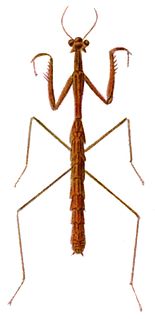
Archimantis latistyla, commonly known as the large brown mantis is a species of mantid native to Australia. The large brown mantis has two subspecies, a widespread subspecies and the stick mantis ghost from Bundabergs Turtle Sands. The stick mantis ghosts are not as aggressive as the widespread species but have a defense display used to make the mantis appear larger by flinging its front legs into the air and putting its head down along with its antennae. Large brown mantids are light brown with short winged female and a long winged male. The subspecies from Bundaberg is a pale cream white with a yellow and black eye in between the arms. The large brown mantis female is short winged - her wings reach only half her abdomen and she is not able to fly—but the long winged male has wings that cover the entire abdomen. They have two pairs of wings - the top pair are the wing covers and the bottom wings enable the mantis to fly.

Popa spurca, also known as the African twig mantis, is a species of mantis native to Africa. It takes its common name from its resemblance to twig from a woody plant and grows up to 8 centimetres (3.1 in) long if female or 7 cm (2.8 in) long if male.

Dead leaf mantis is a common name given to various species of praying mantis that mimic dead leaves. It is most often used in reference to species within genus Deroplatys because of their popularity as exotic pets. Examples include D. desiccata, D. lobata, and D. philippinica. Other species to which the term may apply include Acanthops falcataria, A. falcata, and Phyllocrania paradoxa.

Brunneria is a genus of praying mantises in Family Mantidae. They are often called stick mantis for their slender shape and the species of the genus are native to the Americas.
Aethalochroa ashmoliana, common name Iranian stick mantis, is a species of praying mantis found in India, Iran, Pakistan, and Sri Lanka.
Aethalochroa insignis, common name Indian stick mantis, is a species of praying mantis found in India that was originally identified as a variety of A. ashmoliana.

Stick mantis and twig mantis are common names applied to numerous species of mantis that mimic sticks or twigs as camouflage. Often the name serves to identify entire genera such as is the case with:
Grass mantis is a common name mostly given to various species of praying mantis that mimic grass or other slender vegetation. Species to which this name has been applied include but are not limited to:
Pseudovates peruviana, common name Peruvian stick mantis, is a medium-sized species of praying mantis native to South America and more specifically to Peru.
Aethalochroa affinis, commonly known as the Pakistani stick mantis, is a species of praying mantis in the genus Aethalochroa native to Pakistan.
Aethalochroa spinipes, common name stick mantis, is a species of praying mantis native to Pakistan and India.

Bark mantis is a common name given to various species of praying mantis, especially those with cryptic camouflage resembling tree bark. Examples include:

Bolbe is a genus of praying mantises, sometimes called by the common name Ground Mantis, that is found in Australia. It is in the family Iridopterygidae of the order Mantodea, the mantis.
Toxoderidae is a family of praying mantises.

Mantises are an order (Mantodea) of insects that contains over 2,400 species in about 430 genera in 30 families. The largest family is the Mantidae ("mantids"). Mantises are distributed worldwide in temperate and tropical habitats. They have triangular heads with bulging eyes supported on flexible necks. Their elongated bodies may or may not have wings, but all Mantodea have forelegs that are greatly enlarged and adapted for catching and gripping prey; their upright posture, while remaining stationary with forearms folded, has led to the common name praying mantis.

Schizocephala is a genus of praying mantises in the monotypic tribe Schizocephalini. It is represented by a single species, Schizocephala bicornis. It is distributed across Pakistan, India, Nepal, Sri Lanka and the Sunda Islands.









